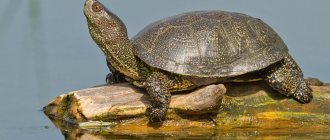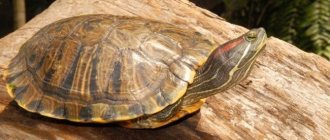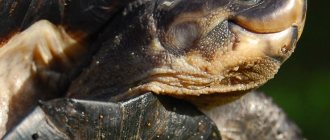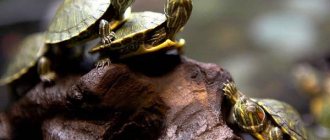For some reason, many people, when buying a turtle to keep at home, think that this animal does not require special care and can live peacefully in an apartment. However, this is not entirely true; perhaps, unlike dogs or cats, they do not have as many needs, but it is still worthwhile to properly equip the place where they are kept, and also think about their diet. First of all, it’s worth figuring out what to feed a river turtle at home, because the health and full development of this reptile depends on proper nutrition.
Types of turtles and their tastes
Turtles in their natural environment feed according to their needs - they eat what the body needs, or, in the absence of abundance, what they can find.
At home, the diet depends entirely on the owner, who must take a responsible approach to creating a menu, ensure that it is balanced, and that the pet’s body receives all the necessary nutrients and microelements. In the opposite situation, the turtle will begin to get sick and may die. Experts divide turtles according to the type of food they eat into three groups:
- Predators. Up to 70-90% of their diet is animal food, and only 10-30% is plant food. Predators love meat. These reptiles also include aquatic ones, whose main diet consists of fish and seafood.
- Omnivores. Animal and plant food are distributed approximately equally.
- Herbivores. The main food is plants, and only 5% is animal products.
Predatory
The main diet consists of lean fish. As practice shows, the best choice is hake, pollock and cod from sea fish, as well as bream, bleak and perch from freshwater. There is no particular difference or preference between marine and freshwater species.
It is recommended to give your pet liver weekly. It can be either fish, beef or chicken. Young turtles need to cut the fish into small pieces. The spine can be left, but the ribs must be removed.
Adults can eat large pieces, and if the fish is small, then you can feed it whole.
The following food products can be used as additional feed:
- Seafood - octopus tentacles, shelled shrimp cephalothorax, small squid and mussels;
- Liver - including the liver of various animals, chicken or beef heart, as well as live food in the form of baby frogs or mice. It is strictly not recommended to feed turtles with meat, minced meat, sausages, etc.;
- Others (as a rule, given to young animals) - mealworms, food cockroaches, daphnia, snails without shells.
The food given to predatory turtles does not require heat treatment, that is, it must remain raw. First of all, this applies to various additives, for example, shrimp should be gray, not pink.
What to feed at home?
The diet of domestic turtles depends on their species. At the same time, there is a list of foods that should not be served under any circumstances. Both land and water turtles are not suitable for the meat of domestic or wild poultry - chickens, ducks, geese, game, including boiled, any food that has undergone heat treatment (fried, boiled, stewed, steamed, baked vegetables, fish, meat). The turtle’s body will not be able to digest any prepared food from the human table; it will turn sour in the stomach, the reptile will get sick, and may even die.
Important! The food in the turtle's feeder becomes unfit for consumption after three hours. It is not recommended to leave leftovers until the next feeding.
Experts do not recommend overfeeding your pets with plant foods rich in oxalates: spinach, peas, cabbage. All turtles, except tropical species, should not be treated with citrus fruits, nuts and tomatoes.
Important! When creating a table for your pet, it is necessary to observe the measure. Herbivorous turtles should not be given meat, even for the sake of experiment, and sea turtles should not be fed with vegetation.
What does a sea turtle eat?
The main principle when feeding sea turtles is not to overfeed. As a rule, these are carnivorous animals, so the basis of their diet is protein food.
What do sea turtles eat:
- special food for turtles;
- fish;
- seafood;
- fish food;
- vegetables;
- insects;
- aquarium plants.
A peculiarity of the digestive system of sea turtles is that saliva is not produced in the mouth. They eat all the food they receive or catch in the water. Breeders often transfer feeding animals to another container, and the water in the main aquarium remains clean.
A mandatory supplement in the diet is calcium, without which it is impossible to build a strong shell.
With age, these predators begin to eat more plant foods, and the proportions of their diet change. Protein products should make up only a quarter of the total volume, and 75% should be plant-based “dishes”.
What do river brothers eat?
What to feed a river turtle, what does a swamp turtle eat, how to properly feed a turtle in an aquarium - these questions certainly arise for those who are faced with the need to care for these reptiles for the first time.
Swamp and river turtles are the most common species of aquatic turtles kept at home.
Being predators, aquatic turtles are happy to treat themselves to low-fat fish - live or defrosted; the entrails and bones, especially for young individuals, do not need to be cleaned.
Fish products are given to adult reptiles whole or in pieces, by grinding or finely chopping the bones.
Fish suitable for feeding:
- perch;
- whiting;
- crucian carp;
- cod;
- hake.
Occasionally, turtles can be treated to fatty varieties of fish: sprat, herring, capelin, sprat. Before serving, such fish is soaked in hot water. They love animals and caviar, so you can’t spoil them often.
Seafood options include shrimp, squid, mussels, octopus, and raw scallop. River delicacies include frogs (you should consult a veterinarian about acceptable species), and the tail of crayfish (once a week).
Low-fat meat products - boiled chicken, chicken and beef liver. To preserve the hunter's instinct, turtles are treated to small rodents - naked mice, rat pups. Fatty varieties of beef, pork, lamb are completely excluded from the diet; minced meat, as well as sausages, cat and dog food are not given.
The diet is varied:
- Specialized dry food (pellets, tablets, sticks, flakes, etc.),
- Insects sold in pet stores (bloodworms, grasshoppers, crickets, feed cockroaches),
- Molluscs, invertebrates, amphibians (slugs, small snails with shells, tadpoles).
- Live aquarium fish - guppies, swordtails, goldfish.
You can “season” a meat feast with salad plants (lettuce, dandelion, parsley, dill), beets, carrots, cabbage, pumpkin pulp, and you can also offer apples and pears.
What does a land turtle eat?
It is easier for aquatic turtles, regardless of whether they are sea, river or swamp, to create a menu than their land counterparts. The bulk of land-dwelling reptiles are vegetarians. The diet is formed in such a way that, in addition to taste, it provides the body with useful substances - minerals, vitamins.
Diet of land turtles:
- 80% - greens: leafy greens (salads and edible leaves, including dandelions, carrot and beet tops, herbs, flowers, parsley, dill, succulents, a small amount of onions, sprouted beans, spinach, sorrel, basil.
- 15% - vegetables: cucumbers, zucchini, pumpkin, carrots, bell peppers, tomatoes. Occasionally, in small portions, you can treat radishes, radishes, garlic cloves, cabbage, and beets.
- Less than 5% - unsweetened fruits: apples, pears, apricots, nectarines, peaches, peeled watermelon pulp, peeled orange or grapefruit in small quantities, bananas.
- Supplement once a week - asparagus, mushrooms (including dried russula, boletus and champignons), seaweed, soybean meal, yeast, bran.
Important! Vegetarian land turtles should not be fed fish, meat and dairy products, including fermented milk and cheese, potatoes, various cereals, white and brown bread, pasta, and sweet dates. Cat and dog food is prohibited.
Omnivorous turtles will not refuse dishes suitable for predators and herbivorous species.
What do baby turtles eat?
During childhood, turtles need to satisfy their need for vitamins and microelements that promote healthy growth and development. The cubs need to be fed in a quiet place so that nothing threatens its peace.
The diet will be based on granules or capsules of ready-made food - sold in the appropriate department of pet stores. Such food is well balanced taking into account the type of reptile. Pets are given food every day - preferably in the morning or lunchtime, when they are most active.
A variety of natural food, as well as supplements that will help raise a healthy animal, will not harm small turtles.
For babies, all food is prepared in a special way:
- Dry food is crushed with a knife into small fractions.
- Fruits larger than blueberries should be mashed or cut.
- The food is seasoned with special vitamins and calcium supplements - three times a week.
To ensure that the turtles receive vitamin D, they are given sunbathing under an ultraviolet lamp.
Reviews
German Leonidovich, 34 years old, Kharkov
I work in a clinic and periodically I get so tired of the noise and bustle that I come home to relax. Unfortunately, I am allergic to wool, so I got myself a river turtle as a pet. What can I say: calm, flexible, quite intelligent. I can’t assure that this is a girl (my friends brought her to me), but for some reason I wanted to name her Dusya. Sometimes we are very close and spend time together, watching TV, and I stroke her shell. And, by the way, the river turtle turned out to be not a river turtle at all; it spends most of its time on land. In short, this is the most docile pet, quiet, calm, and does not eat very much. Dusya is the only turtle so far, but not the last, soon I want to finally find out her gender and find her a boyfriend or girlfriend.
Daria Viktorova, 21 years old, Solnechnogorsk
My father brought me a river turtle when he was returning from a business trip in his car. According to dad, she ran through his path. He was afraid of crushing her and braked in time, got out, took her in his arms and decided to give her to me. Then Krosh was very small, but in 7 years he grew up and became quite a large individual. He doesn’t really like water, and if I put him in the bath and try to move away, Krosh tries to get out, he asks to come to me. There was a time when it seemed to me that he was sick. No matter what I gave him to eat, he refused. It even seemed to me that his shell would soon completely fall off, because he was becoming softer and softer. It turns out that he simply did not have enough food fortified with calcium. Since then, I periodically pamper my pet with snails and shrimp.
Danila Arsenievich, 54 years old, Kislovodsk
My wife and I spend most of our time in the city, but on weekends we come to the dacha to visit our turtle Masha. Our grandchildren caught it for us not far from the river. Since then, Masha lives most of the time with a neighbor, and when we arrive at the dacha, we take her to our place. In summer and spring we release it onto the lawn. When we were young, we kept both hamsters and parrots - everything was not the same, they either made noise or smelled. But with our Masha there are no such worries.
Principles and procedures of feeding
It is better to feed turtles during their active hours - in the morning, at lunch, or a couple of hours before bedtime. You can tell that your pet is hungry by its behavior - it will actively examine the bottom of the terrarium or aquarium.
General rules for feeding turtles:
- Young animals are fed daily, and adult turtles - 2-3 times a week.
- Turtles should not be left hungry for long periods of time.
- The portion for one feeding is calculated from the volume that the turtle will eat in half an hour.
- You cannot spoil turtles: if she eats something with appetite, this does not mean that the food is beneficial;
- Be sure to give calcium once a week - 100 mg of nutrition per 1 kg of weight (carbonate, ground eggshells, calcium palminate, turtle food, bone meal, sepia).
The transfer of turtles from ready-made store food to natural food and vice versa is done gradually - it will take at least a couple of weeks. If several turtles are adjacent at the same time, during feeding it is necessary to ensure that there is enough food for everyone.
Any species of turtle will be harmed by an excess of the following foods:
- spinach;
- turnip;
- leaf mustard;
- wild cruciferous plants;
- cereals;
- forest mushrooms;
- raw liver or kidneys;
- any nuts.
Land turtles are fed from a feeder, their aquatic counterparts are fed from tweezers, or food is thrown into the aquarium or placed on a bank near the water. The latter method is the most convenient, as it allows you to maintain water quality for a longer period. You should not teach him to eat from his hands - at some point the pet may confuse his fingers with food and bite.
Additional information
Scientists identify 13 subspecies of the marsh turtle in nature, but only 5 are found in Russia. In the summer, turtles live near bodies of water and, if an enemy appears, they rush into the water and dive to the bottom, often burying themselves in silt. Swamp turtles hibernate in the fall, in October, thereby waiting out the winter at the bottom of reservoirs.
Adults and large
individuals can at times be hostile and try to bite. It is necessary to take them by the edge of the back of the shell, since the head on the long neck has great physical activity. The bite can be very painful, since, having grabbed the soft part of the hand with its mouth, the turtle convulsively clenches its jaws several times. However, if you treat this animal well, they instantly become tamed, stop hiding their head under their shell, and, on the contrary, pull it towards the owner-breadwinner.
Turtle's relationship with drinking water
Aquatic species of turtles do not need additional drink, since they a priori moisten any food with water due to the lack of saliva in the mouth.
Land reptiles have a special relationship with drinking water. The structure of their head does not allow them to fully drink - when water gets into their mouth, it pours out through their nostrils. There are species that never drink at all, content with moisture from food. Others need very little water.
In addition to food, the source of water is also the external environment - moisture enters the body during swimming or baths. Serious dehydration can cause a reptile to drink water. To prevent this from happening, it is important to properly plan your diet, including juicy fruits and vegetables. For example, fresh dandelion and clover leaves consist of 85% water, which will be enough for the reptile’s body.
Experts also recommend giving turtles baths. To do this, once a week I pour a little water into a shallow container and place the pet there. 30 minutes of bathing is enough for him to replenish the existing lack of moisture. Water should not enter the reptile's nostrils.
Features of feeding by season
Despite the fact that at home turtles practically do not feel the change of seasons, by winter they become less active. Owners of an exotic pet should remember that it is better not to let it hibernate - it requires special care, and in the spring the animal may not wake up.
As activity decreases, the amount of food consumed also decreases. However, the menu should remain as varied as possible. During this period, seasonal vegetables will be useful for turtles - cabbage, beets, carrots, as well as raw meat and boiled eggs. All products are consumed in moderation.
In addition, calcium supplements continue to be given, and special multivitamins are given to prevent diseases.
If there are doubts about the balance of the home diet, you can switch the animal to ready-made food.
Guppy fish are a treat for any turtle
If you own an aquarium with fish, you should not put a turtle in it. She will simply eat all the inhabitants of the aquarium and remain the rightful owner of the vacated territory, unless, of course, this does not affect her life activity. But you can use fish, for example the same guppies, to feed your pet. This will greatly please your beloved turtle. But you shouldn’t get carried away either, otherwise your reptile will suffer from overeating.











